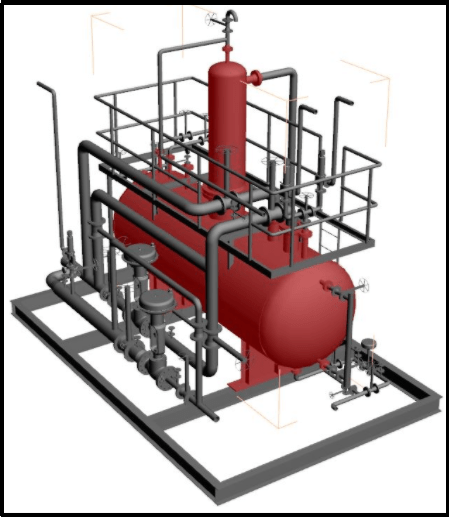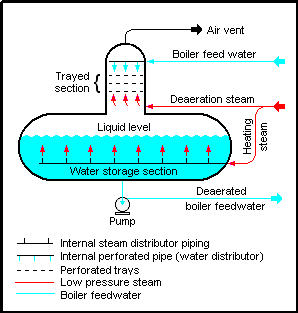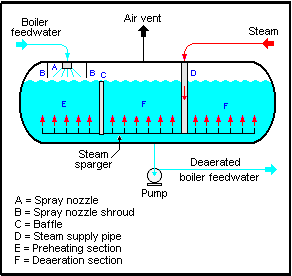
Why Deaerator?
It is the utmost necessary to remove the dissolved gases from the feed-, as the presence of Dissolve Oxygen in the leads to pitting corrosion in the high-pressure pipes/metal tubes and the presence of CO2 gas reduces the pH level of the by generating Carbonic Acid. So to avoid these two consequences, we have to remove these gases. Deaerator is one of the most effective & thermal efficient devices to remove dissolved gases. It is commonly employed in any chemical process industry or Power Plants wherever the boiler is utilized for steam production from boiler feed.
Principle of Deaerators: It works on two principles
- Henry’s Law
- Temperature & Gas Solubility Relation.
- Henry’s Law:
The mass of dissolved gas in a given volume of solvent at equilibrium is proportional to the partial pressure of the gas. As in the Deaerator, the pressure of the feed- is low due to the surface distribution of the through the nozzles in it. As the pressure of the fluid is reduced so the solubility of the gases decreases.
- Temperature & Gas Solubility Relation:
According to this relation, the solubility of the dissolved gases reduces as the temperature increases. That is the reason we maintain a high temperature of the feed- and Due to the counter flow of and steam in the Deaerator, scrubbing action takes place and the steam carries away the gases with it.
Types of Deaerators
- Tray types Deaerator

Tray type deaerators contain perforated trays within the top of the Deaeration section. The bottom portion volume is high for used as storage for boiler feed . Feed to deaerator enters into the perforated trays where the area and residence time is growing to contact with steam. Then the goes to the horizontal storage section where steam is pass through sparger pipe to withdrawn the remaining traces of dissolved gases and keep the stored at its saturation temperature.
- Spray type Deaerator

Spray Deaerator type deaerator contains spray nozzle in feed entry space. It’s then preheated and draughted and sent to the storage section. In the storage section also steam is additional to stay at its saturation temperature.
Working & Construction
Deaerator as the name signifies deaerates the air or removes the air from the condensate and feed cycle. Generally, Deaerator is placed after LP (Low Pressure) heaters and before BFP (Boiler Feed Pump). After LP heaters, the condensate comes to the Deaerator. In the Deaerator, the is sprinkled through the Nozzles to increase its surface area for better scrubbing by steam and to reduce the pressure of the fluid as the surface area has increased. Simultaneously the steam is admitted from the bottom of the deaerator for a counterflow arrangement
of Steam and Condensate. Steam used for the de-aeration of feed is called pegging steam and its pressure is around 7 kg/cm2.
In the air removing process, we have to ensure total removal of air, non-condensable gases, and dissolved gases from the system otherwise there may be chances of corrosion in the feed line for this we dose Hydrazine (N2H4). This hydrazine reacts with and removes oxygen and makes nitrogen gas which is inert in nature. This hydrazine dosing position varies from design to design. In some designs, there is also provision for the vent condenser. This vent condenser is placed above the Deaerator. In this vent condenser upcoming feed is heated before going to Deaerator by steam which leaving from Deaerator to venting. This serves two purposes; first, it heats feed before going to Deaerator and second, it utilizes the left energy of steam which going out to the atmosphere. Commonly Deaerator is found at a very high level in the plant because it gives the NPSH (Net Positive Suction Head) to booster pump and BFP (Boiler Feed pump). If this NPSH is not available then there is a chance of churning and cavitation in BFP and there is a chance of damage to BFP material. This NPSH is nothing but head or pressure required at the suction of BFP otherwise there will be flashing of or steaming off. This phenomenon occurs when the pressure at the suction side of the inlet is below its vapor pressure and its temperature is high. To avoid this, NPSH available is always higher than the NPSH required. Deaerator is placed above the BFP and there is the provision of a booster pump which gives sufficient pressure to BFP for its smooth operation.
Other benefits of Deaerator:
Deaerator acts as extra storage that provides a reserve amount of boiler feed throughout upstream supply failure for momentary periods commonly for about twenty minutes. In some of the Plants, Deaerator is additionally used for dosing oxygen-scavenging chemicals like hydrazine or Hydroquinone.



